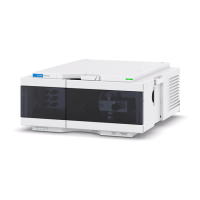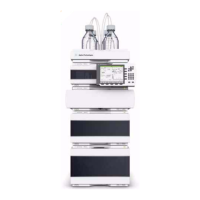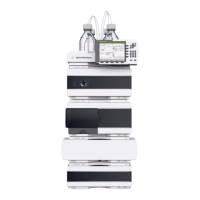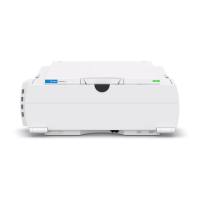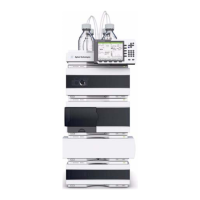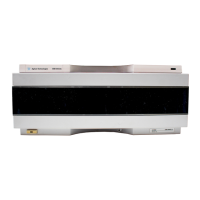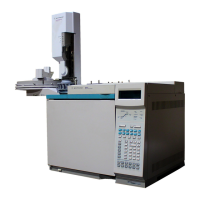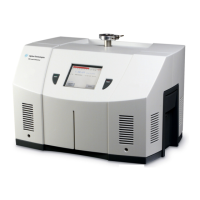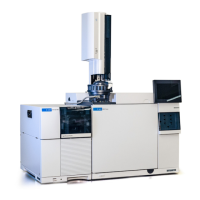Do you have a question about the Agilent Technologies 1260 and is the answer not in the manual?
Provides an overview of the detector, instrument, and internal connectors.
Details the detector's optical components, including light sources and spectrograph.
Explains the EMF feature for monitoring component usage and scheduling maintenance.
Details the industrial design and packaging concept of the module.
Describes the various electrical connectors and their functions on the module.
Lists and details the different interfaces available on Agilent 1200 Series modules.
Explains the location and function of the 8-bit configuration switch for module settings.
Information on environmental conditions, power, and bench space for optimal instrument performance.
Details the physical characteristics such as weight, dimensions, and operating ranges.
Outlines the detector's performance metrics like data rate, wavelength range, and noise.
Steps and precautions for unpacking the detector module and checking for damage.
How to arrange modules for optimal system flow and minimum delay volume.
Procedure for installing the detector module into the system stack.
Guidance on connecting flow cell capillaries and waste tubing.
Instructions for configuring the detector's LAN connection.
Initial steps for setting up LAN communication, including MAC address identification.
Essential TCP/IP parameters for network operation and configuration methods.
Location and function of the 8-bit configuration switch for module settings.
Options for determining TCP/IP parameters after power-on.
Setting network speed and duplex modes via configuration switches.
Steps for automatic IP address assignment using the Agilent BootP Service.
Procedure to save configuration parameters permanently using Bootp.
How to manually alter stored parameters using Telnet or Instant Pilot.
Guide to preparing the system and setting up an HPLC analysis.
Steps before system use, including solvent information and priming.
Lists parts and material required for analysis setup and specific conditions.
General guidance on system optimization, referring to another section.
Steps to turn on and prepare the HPLC system components and software.
Configuration details for special detector settings, including control and configuration.
Overview of detector parameters for optimizing performance.
Summary of parameters and their impact on chromatography.
Detailed guide on optimizing key detector parameters like flow cell and peak width.
Techniques for achieving selective detection of compounds, such as peak suppression.
Explains status indicators, error messages, and test functions for troubleshooting.
Location and meaning of the module's power supply and status indicators.
Overview of available tests and screens via different user interfaces.
Information on using Agilent Lab Advisor for diagnostics and maintenance.
Explains how error messages are displayed and what they signify.
Lists generic error messages applicable to Agilent HPLC modules.
Specific error messages related to the detector's operation and components.
Runs a series of individual tests to automatically evaluate detector performance.
Checks the correct operation of the filter assembly using the holmium oxide filter.
Verifies correct operation of the micromechanical slit by monitoring lamp intensity.
Measures leakage current from each diode to check for leaking diodes.
Measures lamp and optics intensity over the full wavelength range.
Uses absorbance maxima to verify wavelength accuracy with the holmium oxide filter.
Determines maximum noise on the spectrum with the flowcell removed.
Measures detector noise over a period of 20 minutes with the flowcell removed.
Measures lamp intensity with and without the flow cell to assess light absorption.
How to use the built-in test chromatogram function.
Procedure for verifying and recalibrating wavelength accuracy using deuterium emission lines.
Information on the pre-defined test chromatogram and its settings.
How to access detailed information about detector assemblies via ChemStation.
Verifies correct operation of the digital-analog converter by applying a digital test signal.
Overview of the module's design for easy maintenance from the front.
Safety precautions related to hazardous materials, eye damage, and electrical shock.
Summarizes maintenance procedures, frequency, and notes for the detector.
Instructions for cleaning the detector module case safely.
Steps for replacing the deuterium or tungsten lamp, including safety warnings.
Procedure for replacing the flow cell with different types or for repair.
Detailed maintenance steps for standard, semi-micro, and micro flow cells.
Steps for replacing blocked capillaries on a standard flow cell.
Steps for replacing or cleaning nano flow cells when contaminated or leaky.
Procedure for cleaning or exchanging the holmium oxide filter if contaminated.
Steps to identify and correct leaks in the flow cell area or capillary connections.
Instructions for replacing corroded or broken parts of the leak handling system.
Procedure for replacing the CompactFlash card in specific detector models.
Instructions for upgrading or downgrading the module's firmware.
Lists all maintenance parts with their item numbers, part numbers, and descriptions.
Details parts for the standard flow cell, including screws, gaskets, and capillaries.
Lists specific parts for the semi-micro flow cell, including screws, gaskets, and capillaries.
Details parts for the micro flow cell, including screws, gaskets, and capillaries.
Lists parts for the SST preparative flow cell, including screws, gaskets, and capillaries.
Lists parts for the quartz preparative flow cell, including tubing and fittings.
Details available kits and generic parts for nano flow cells.
Lists parts for the high-pressure flow cell, including seal rings and capillaries.
Describes accessory kits and their contents for installation and repair.
General overview of different cable types used with Agilent modules.
Details analog cables, including connectors and signal names.
Information on remote cables for connecting to Agilent modules and integrators.
Details BCD cables for connecting to Agilent modules and general purpose instruments.
Information on CAN and LAN cables used for module communication.
Describes RS-232 cables for connecting Agilent 1200 modules to a PC.
General safety precautions for operating, servicing, and repairing the instrument.
Information on the WEEE Directive and product disposal requirements.
Guidelines regarding radio interference and cable usage.
Manufacturer's declaration regarding sound pressure emission levels.
Information on UV-radiation limits and typical values from UV lamps.
Recommendations for flow cell care and solvent usage to protect functionality.
Declaration of conformity for the Holmium Oxide Filter.
Information on accessing Agilent's website for product and service updates.
Provides an overview of the detector, instrument, and internal connectors.
Details the detector's optical components, including light sources and spectrograph.
Explains the EMF feature for monitoring component usage and scheduling maintenance.
Details the industrial design and packaging concept of the module.
Describes the various electrical connectors and their functions on the module.
Lists and details the different interfaces available on Agilent 1200 Series modules.
Explains the location and function of the 8-bit configuration switch for module settings.
Information on environmental conditions, power, and bench space for optimal instrument performance.
Details the physical characteristics such as weight, dimensions, and operating ranges.
Outlines the detector's performance metrics like data rate, wavelength range, and noise.
Steps and precautions for unpacking the detector module and checking for damage.
How to arrange modules for optimal system flow and minimum delay volume.
Procedure for installing the detector module into the system stack.
Guidance on connecting flow cell capillaries and waste tubing.
Instructions for configuring the detector's LAN connection.
Initial steps for setting up LAN communication, including MAC address identification.
Essential TCP/IP parameters for network operation and configuration methods.
Location and function of the 8-bit configuration switch for module settings.
Options for determining TCP/IP parameters after power-on.
Setting network speed and duplex modes via configuration switches.
Steps for automatic IP address assignment using the Agilent BootP Service.
Procedure to save configuration parameters permanently using Bootp.
How to manually alter stored parameters using Telnet or Instant Pilot.
Guide to preparing the system and setting up an HPLC analysis.
Steps before system use, including solvent information and priming.
Lists parts and material required for analysis setup and specific conditions.
General guidance on system optimization, referring to another section.
Steps to turn on and prepare the HPLC system components and software.
Configuration details for special detector settings, including control and configuration.
Overview of detector parameters for optimizing performance.
Summary of parameters and their impact on chromatography.
Detailed guide on optimizing key detector parameters like flow cell and peak width.
Techniques for achieving selective detection of compounds, such as peak suppression.
Explains status indicators, error messages, and test functions for troubleshooting.
Location and meaning of the module's power supply and status indicators.
Overview of available tests and screens via different user interfaces.
Information on using Agilent Lab Advisor for diagnostics and maintenance.
Explains how error messages are displayed and what they signify.
Lists generic error messages applicable to Agilent HPLC modules.
Specific error messages related to the detector's operation and components.
Runs a series of individual tests to automatically evaluate detector performance.
Checks the correct operation of the filter assembly using the holmium oxide filter.
Verifies correct operation of the micromechanical slit by monitoring lamp intensity.
Measures leakage current from each diode to check for leaking diodes.
Measures lamp and optics intensity over the full wavelength range.
Uses absorbance maxima to verify wavelength accuracy with the holmium oxide filter.
Determines maximum noise on the spectrum with the flowcell removed.
Measures detector noise over a period of 20 minutes with the flowcell removed.
Measures lamp intensity with and without the flow cell to assess light absorption.
How to use the built-in test chromatogram function.
Procedure for verifying and recalibrating wavelength accuracy using deuterium emission lines.
Information on the pre-defined test chromatogram and its settings.
How to access detailed information about detector assemblies via ChemStation.
Verifies correct operation of the digital-analog converter by applying a digital test signal.
Overview of the module's design for easy maintenance from the front.
Safety precautions related to hazardous materials, eye damage, and electrical shock.
Summarizes maintenance procedures, frequency, and notes for the detector.
Instructions for cleaning the detector module case safely.
Steps for replacing the deuterium or tungsten lamp, including safety warnings.
Procedure for replacing the flow cell with different types or for repair.
Detailed maintenance steps for standard, semi-micro, and micro flow cells.
Steps for replacing blocked capillaries on a standard flow cell.
Steps for replacing or cleaning nano flow cells when contaminated or leaky.
Procedure for cleaning or exchanging the holmium oxide filter if contaminated.
Steps to identify and correct leaks in the flow cell area or capillary connections.
Instructions for replacing corroded or broken parts of the leak handling system.
Procedure for replacing the CompactFlash card in specific detector models.
Instructions for upgrading or downgrading the module's firmware.
Lists all maintenance parts with their item numbers, part numbers, and descriptions.
Details parts for the standard flow cell, including screws, gaskets, and capillaries.
Lists specific parts for the semi-micro flow cell, including screws, gaskets, and capillaries.
Details parts for the micro flow cell, including screws, gaskets, and capillaries.
Lists parts for the SST preparative flow cell, including screws, gaskets, and capillaries.
Lists parts for the quartz preparative flow cell, including tubing and fittings.
Details available kits and generic parts for nano flow cells.
Lists parts for the high-pressure flow cell, including seal rings and capillaries.
Describes accessory kits and their contents for installation and repair.
General overview of different cable types used with Agilent modules.
Details analog cables, including connectors and signal names.
Information on remote cables for connecting to Agilent modules and integrators.
Details BCD cables for connecting to Agilent modules and general purpose instruments.
Information on CAN and LAN cables used for module communication.
Describes RS-232 cables for connecting Agilent 1200 modules to a PC.
General safety precautions for operating, servicing, and repairing the instrument.
Information on the WEEE Directive and product disposal requirements.
Guidelines regarding radio interference and cable usage.
Manufacturer's declaration regarding sound pressure emission levels.
Information on UV-radiation limits and typical values from UV lamps.
Recommendations for flow cell care and solvent usage to protect functionality.
Declaration of conformity for the Holmium Oxide Filter.
Information on accessing Agilent's website for product and service updates.
| Brand | Agilent Technologies |
|---|---|
| Model | 1260 |
| Category | Security Sensors |
| Language | English |
